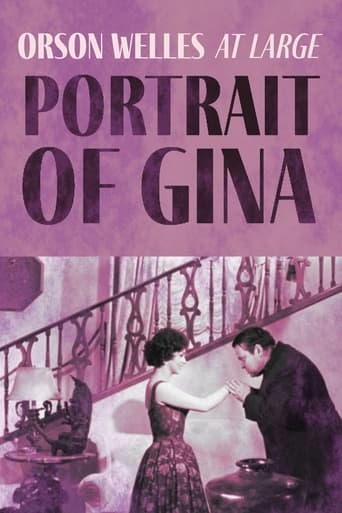Brian Camp
"Portrait of Gina" (onscreen title: "Viva Italia"), directed by and starring Orson Welles, was meant to be the pilot of a proposed series for ABC Television. ABC rejected it and it went unseen for nearly three decades until the film print was rescued from storage at the Ritz Hotel in Paris after Welles' death. If you've seen other aborted, unfinished, or undistributed projects of Welles', you'll be prepared for the rambling, self-indulgent nature of this piece but, like me, you'll enjoy it just as much as you did those other snippets. (Who would seek them out if they weren't already a devoted fan?) It's Orson being Orson; what's not to love? Even when he doesn't have a strong focus, the pace is breezy and the touch is whimsical as he takes us on quite an idiosyncratic tour of Italy, with the closing interview with Italian star Gina Lollobrigida, the ostensible subject of the piece, treated almost as an afterthought. Also appearing on camera are actor Rossano Brazzi and director-actor Vittorio De Sica. All interviewees speak English, although Gina occasionally reverts to Italian, sometimes translated into English by Orson and sometimes not.The interviews have an odd texture, given that Welles seems to have filmed his questions and responses separately (and possibly long distances away and much time later). He seems to at least have been sitting opposite De Sica and Lollobrigida when they speak, but I'm doubtful he was ever face to face with Mr. Brazzi, who is interviewed on the deck of a passenger ship. Welles talks quite a bit more than his subjects and tends to pontificate rather than interrogate, even putting words into his interviewees' mouths, although I'm sure they were unaware he would be doing that. One of the themes discussed by all three subjects is the peculiar love-hate relationship between the Italian public and their homegrown stars. Welles points out, for instance, that while De Sica was a popular movie star in Italy, his directorial efforts were generally ignored there, though lauded by the rest of the world.In between the interviews, Welles goes off on assorted tangents, including a look at cartoonist Saul Steinberg's book of drawings of Italy; a picturesque trip to Lollobrigida's hometown, Subiaco; and random montages of the Italian people at work and play. There are nice shots of castle ruins in the countryside. There is also another interview worth noting, although not with a celebrity. Anna Gruber, a teacher who befriended Gina when she was a student and maintained a long correspondence with her during the war and afterwards, reveals that Gina never talked about movies in her letters. (Again, it's not clear to me that Welles was ever face to face with Ms. Gruber, who also speaks English.) Welles' wife at the time, Paola Mori, an Italian actress who was in Welles' film, MR. ARKADIN, joins Orson in some early shots (most of them filmed against a plain backdrop God-knows-where) and is allowed to comment from time to time (and has the funniest line in the film) and is the only one seen actually operating a movie camera—a hand-held job--although she's nowhere near the scenes she's supposedly filming, (e.g., shots of villagers doing the Tarantella).Despite its ramshackle construction, it's an engaging 26 minutes and reminds us why Welles holds such a special place in the hearts of film lovers the world over. Welles reveled in making movies, even when he had just a 16mm camera and a wisp of an idea, as you'll know from the pieces collected in "Orson Welles: The One-Man Band" (1995). I first learned about this film from a piece by Phil Hall posted on the Cinephilia and Beyond website and I then searched for it on YouTube and watched it. Hall informs us that "The film had its first public screening at the 1986 Venice Film Festival. However, when Lollobrigida finally saw the film at the festival (Welles, apparently, never showed her the footage), she was extremely unhappy with the production and began legal proceedings to prevent its distribution. 'Portrait of Gina' has turned up on German, French, and Swiss television, and it has been screened in non-theatrical U.S. retrospectives of Welles' films. However, there has been no official DVD release of this title due to Lollobrigida's legal actions." There's no indication, though, of why Ms. Lollobrigida took issue with the film. Still, as Hall sums it up, "despite its flaws, the film deserves to be seen — after all, second-tier Orson Welles is more fascinating than first-tier anyone else." Amen, brother.

